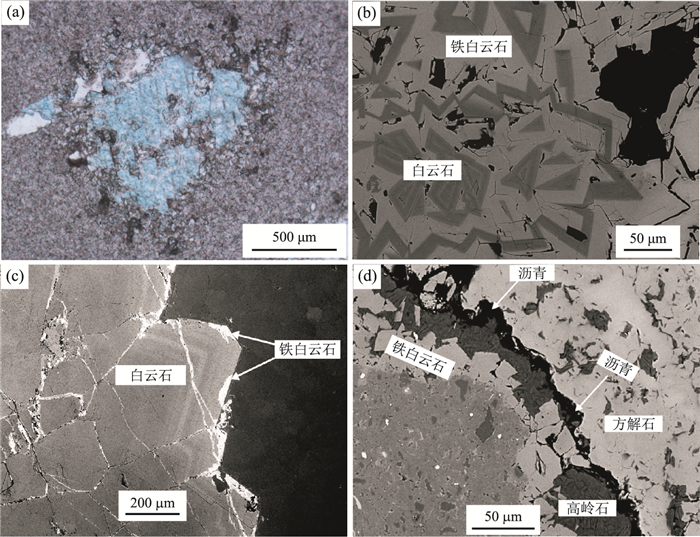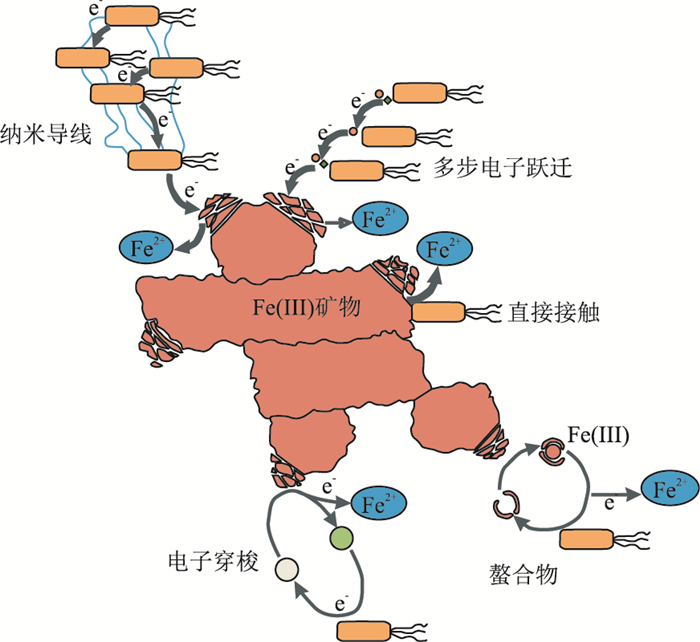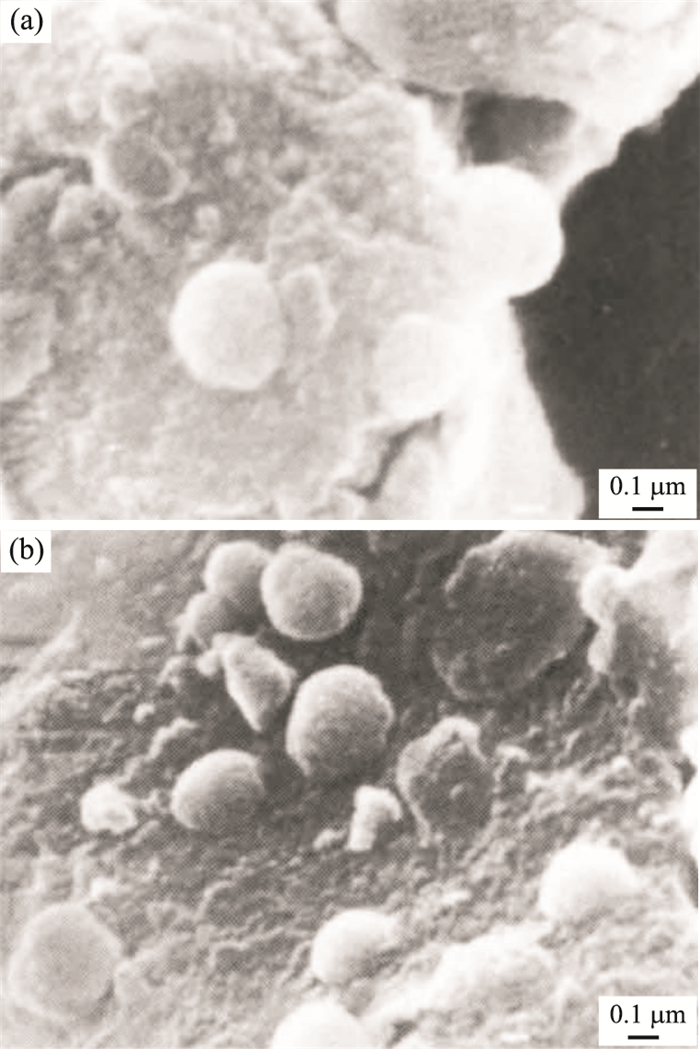Mineralogical Characteristics of Ankerite and Mechanisms of Primary and Secondary Origins
-
摘要: 长期以来,铁白云石的命名划分标准混乱,一直被当成高温及次生的产物.综述了国内外铁白云石的研究进展,详细探讨了铁白云石的矿物学特征,特别在其成因中加入了微生物因素,运用地质微生物学探讨原生铁白云石的成因机制.研究认为:(1)铁白云石命名划分依据应遵照国际矿物学会的原则,以铁是否替代白云石晶格中半数镁的位置为标准,分为白云石和铁白云石;(2)详述铁白云石矿物学及其晶体特征;(3)铁白云石成因分为原生沉淀及次生两种,微生物介导形成原生白云石的过程中,有助于铁进入到白云石晶格中,增加晶格中铁的含量.Abstract: The compositional break between ferroan dolomite and ankerite has not been well-defined for a long time. Ankerite has always been regarded as a secondary mineral generated at high temperatures. In this paper, progress in mineralogy and origins of ankerite and a link between microbial activity and ankerite are evaluated. Based on documented data:(1) The compositional break based on the "50% rule" principle from International Association of Mineralogy is applied for Ca-Mg-Fe carbonate. Any minerals with more than 50 mol% Fe in the Mg site would be called ankerite; (2) Progresses in mineralogical and lattice characteristics of ankerite are presented; (3) The origins of ankerite are primary and secondary. In the process of microbial mediated primary dolomite, microbe facilitates iron into the dolomite lattice and increases the iron content in the Mg site in its structure. Microbes could be added into the primary sedimentary experiments to promote mediation of the primary ankerite.
-
Key words:
- ankerite /
- primary ankerite /
- microbial origin /
- mineralogy
-
图 1 理想的有序白云石晶体结构图及铁离子的位置
Fig. 1. Atomic structure of an idealized stoichiometric dolomite crystal and preferred sites for elemental substitution of Fe
图 2 次生的铁白云石
a.奥陶系马五段陕338井中,膏溶铸模孔中被后期次生形成的铁白云石充填(张军涛等,2017);b~d.波兰西里西亚盆地始新世-渐新世自生白云岩地层,多种多样不同期次的铁白云石胶结物(Bojanowski, 2014)
Fig. 2. Secondary ankerite
图 3 微生物到铁矿物的电子传递机制
Fig. 3. Mechanisms of electron transfer from microorganisms to Fe (Ⅲ) minerals
图 4 微生物培养实验中含铁量高的白云石SEM图像
Fig. 4. SEM secondary electron images of ferroan dolomite in the bacterial cultural experiments
表 1 双舱法合成铁白云岩固溶体的混合物和晶胞参数
Table 1. Composition and unit-cell parameters of the ankerite solid solutions in double-capsule method synthesized experiments
样品 x a(Å) c(Å) V(Å3) CaMg(CO3)2 0 4.807 6(3) 16.007 0(2) 320.40 ank1 0.158 3 4.810 2(6) 16.052 4(43) 321.66 ank2 0.299 0 4.810 8(2) 16.109 5(17) 322.88 ank3 0.499 6 4.813 1(1) 16.120 0(9) 323.41 ank4 0.648 0 4.818 2(8) 16.154 3(5) 324.79 ank5 1.000 0 4.830 0(9) 16.221 0(8) 327.72 CaFe(CO3)2 1.000 0 4.829 1(3) 16.210 0(1) 327.38 注:表中数据源于Chai and Navrotsky(1996);x.Ca(FexMg1- x)(CO3)2;a和c.晶胞参数;V.晶胞体积. 表 2 不同压力下白云石与铁白云石的晶胞参数
Table 2. Unit-cell parameters of dolomite and ankerite under different pressures
压力(GPa) 白云石晶胞参数 a(Å) c(Å) V(Å3) 0.00 4.806 4(5) 16.006(2) 320.22(8) 0.47 4.802 8(7) 16.962(2) 318.87(9) 1.50 4.791 0(7) 15.856(2) 315.20(9) 2.34 4.784 3(9) 15.785(2) 312.90(11) 2.90 4.777 7(5) 15.730(1) 310.97(6) 3.70 4.770 3(7) 15.653(2) 308.47(10) 4.20 4.767 2(6) 15.611(2) 307.24(8) 4.69 4.763 6(5) 15.582(3) 306.21(8) 压力(GPa) 铁白云石晶胞参数 a(Å) c(Å) V(Å3) 0.00 4.836 0(8) 16.186(2) 327.82(11) 0.97 4.826 5(8) 16.085(2) 324.51(11) 1.90 4.816 3(6) 15.992(2) 321.26(9) 2.56 4.810 9(6) 15.924(2) 319.18(8) 2.97 4.807 0(6) 15.881(2) 317.81(8) 3.40 4.803 8(8) 15.847(2) 316.71(10) 4.00 4.799 0(6) 15.792(2) 314.97(8) 注:表中数据源于Ross and Reeder(1992);a和c.晶胞参数;V.晶胞体积. 表 3 标准白云石、铁白云石衍射数据(ICDD数据)
Table 3. Standard XRD data of dolomite and ankerite from ICDD
标准白云石 标准铁白云石 d I/I0 hkl d I/I0 hkl 4.033 1 101 4.051 <1 101 3.699 3 012 3.714 2 012 2.888 100 104 2.906 100 104 2.670 4 006 2.693 4 006 2.539 3 015 2.556 <1 015 2.404 8 110 2.414 4 110 2.193 25 113 2.203 7 113 2.065 4 021 2.073 <1 021 2.015 4 202 2.024 6 202 1.847 5 024 1.856 2 024 1.805 16 018 1.818 8 018 1.787 21 116 1.797 10 116 1.780 3 009 1.795 5 009 1.567 4 211 1.573 2 211 1.545 7 122 1.550 4 122 1.465 4 214 1.472 4 214 1.444 4 208 1.452 4 208 1.389 4 300 1.394 2 300 表 4 标准白云石、铁白云石晶胞参数(ICDD数据)
Table 4. Standard unit-cell parameters of dolomite and ankerite from ICDD
矿物种类 晶胞参数 a(Å) c(Å) V(Å3) 白云石(36-426) 4.809 0 16.020 0 320.88 铁白云石(41-586) 4.829 0 16.152 0 326.15 表 5 微生物介导的白云石与标准白云石及铁白云石的晶胞参数比较
Table 5. Comparison of unit-cell parameters between dolomites and ankerite
米勒指数
(hkl)微生物介导白云石
d(hkl)Å白云石
d(hkl)Å铁白云石
d(hkl)Å方解石
d(hkl)Å102 3.71 3.69 3.70 3.86 110 2.40 2.41 2.41 2.49 122 1.55 1.54 1.55 1.60 104 2.94 2.89 2.90 3.03 注:微生物介导白云石数据源自 Vasconcelos et al.(1995) . -
Bojanowski, M.J., 2014.Authigenic Dolomites in the Eocene-Oligocene Organic Carbon-Rich Shales from the Polish Outer Carpathians:Evidence of Past Gas Production and Possible Gas Hydrate Formation in the Silesian Basin.Marine and Petroleum Geology, 51(51):117-135.https://doi.org/10.1016/j.marpetgeo.2013.12.001 http://www.sciencedirect.com/science/article/pii/S0264817213002997 Boyd, P.W., Watson, A.J., Law, C.S., et al., 2000.A Mesoscale Phytoplankton Bloom in the Polar Southern Ocean Stimulatedby Iron Fertilization.Nature, 407(6805):695.https://doi.org/10.1029/2011jc006956 doi: 10.1038/35037500 Carballo, J.D., Land, L.S., Miser, D.E., 1987.Holocene Dolomitization of Sugarloaf Sediments by Active Tidal Pumping, Sugarloaf Key, Florida.Journal of Sedimentary Petrology, 57(1):153-165.https://doi.org/10.1306/212F8AD0-2B24-11D7-8648000102C1865D Chai, L., Navrotsky, A., 1996.Synthesis, Characterization, and Energetics of Solid Solution along the Dolomite-Ankerite Join, and Implications for the Stability of Ordered CaFe(CO3)2.American Mineralogist, 81(9-10):1141-1147. https://doi.org/10.2138/am-1996-9-1012 Chaudhuri, S.K., Lack, J.G., Coates, J.D., 2001.Biogenic Magnetite Formation through Anaerobic Biooxidation of Fe (Ⅱ).Applied and Environmental Microbiology, 67(6):2844-2848.https://doi.org/10.1128/aem.67.6.2844-2848.2001 doi: 10.1128/AEM.67.6.2844-2848.2001 Chen, L., Zhang, H.X., Li, Y., et al., 2016.The Role of Microorganisms in the Geochemical Iron Cycle.Scientia Sinica (Vitae), 46(9):1069-1078 (in Chinese with English abstract). http://www.en.cnki.com.cn/Article_en/CJFDTOTAL-JCXK201609003.htm Coale, K.H., Fitzwater, S.E., Gordon, R.M., et al., 1996.Control of Community Growth and Export Production by Upwelled Iron in the Equatorial Pacific Ocean.Nature, 379(6566):621-624. https://doi.org/10.1038/379621a0 Dai, C.C., Zheng, R.C., Wen, H.G., et al., 2008.Origin of Lacustrine Dolomite in the Paleogene Shahejie Formation of Liaodongwan Basin, China.Journal of Chengdu University of Technology (Science & Technology Edition), 35(2):187-193 (in Chinese with English abstract). http://www.wanfangdata.com.cn/details/detail.do?_type=perio&id=cdlgxyxb200802014 de Deckker, P., Last, W.M., 1988.Modern Dolomite Deposition in Continental, Saline Lakes, Western Victoria, Australia.Geology, 16(1):29.https://doi.org/10.1130/0091-7613(1988)016 < 0029:mddics>2.3.co; 2 doi: 10.1130/0091-7613(1988)016<0029:MDDICS>2.3.CO;2 Deer, W.A., Howie, R.A., Zussman, J., 1992.The Rock Forming Minerals.Longman, Essex, 696 Deng, S.C., Dong, H.L., Lü, G., et al., 2010.Microbial Dolomite Precipitation Using Sulfate Reducing and Halophilic Bacteria:Results from Qinghai Lake, Tibetan Plateau, NW China.Chemical Geology, 278(3-4):151-159. https://doi.org/10.1016/j.chemgeo.2010.09.008 Franzolin, E., Merlini, M., Poli, S., et al., 2012.The Temperature and Compositional Dependence of Disordering in Fe-Bearing Dolomites.American Mineralogist, 97(10):1676-1684. https://doi.org/10.2138/am.2012.4126 Gao, J., Zheng, T.L., Deng, Y.M., et al., 2017.Indigenous Iron-Reducing Bacteria and Their Impacts on Arsenic Release in Arsenic-Affected Aquifer in Jianghan Plain.Earth Science, 42(5):716-726 (in Chinese with English abstract). http://www.wanfangdata.com.cn/details/detail.do?_type=perio&id=dqkx201705007 Geider, R.J., 1999.Biological Oceanography:Complex Lessons of Iron Uptake.Nature, 400(400):815-816. http://www.nature.com/nature/journal/v400/n6747/full/400815a0.html Gregg, J.M., Bish, D.L., Kaczmarek, S.E., et al., 2015.Mineralogy, Nucleation and Growth of Dolomite in the Laboratory and Sedimentary Environment:A Review.Sedimentology, 62(6):1749-1769.https://doi.org/10.1111/sed.12202 doi: 10.1111/sed.2015.62.issue-6 Guo, H.L., Zhang, F.S., 1981.Preliminary Analysis on the Laws of Differential Thermal Curves of Siderite, Dolomite-Ankerite and Calcite.Yunnan Chemical Technology, (4):47-51 (in Chinese). http://www.wanfangdata.com.cn/details/detail.do?_type=perio&id=QK000004862216 Hafenbradl, D., Keller, M., Dirmeier, R., et al., 1996.Ferroglobus Placidus gen.nov., sp.nov., a Novel Hyperthermophilic Archaeum That Oxidizes Fe2+ at Neutral pH under Anoxic Conditions.Archives of Microbiology, 166(5):308-314.https://doi.org/10.1007/s002030050388 Hendry, J.P., 2003.Ankerite.In: Middleton, G.V., Church, M.J., Coniglio, M., et al., eds., Encyclopaedia of Sediments and Sedimentary Rocks.Kluwer Academic Publishers, Dordrecht, 19-21. Hilscher, G., Rogl, P., Zemann, J., et al., 2005.Low-Temperature Magnetic Investigation of Ankerite.European Journal of Mineralogy, 17(1):103-106.https://doi.org/10.1127/0935-1221/2005/0017-0103 http://www.wanfangdata.com.cn/details/detail.do?_type=perio&id=deea451c3062ebd6f271b4bc6954fd62 Huang, C.G., Yuan, J.Y., Cao, Z.L., et al., 2014.Simulation Experiment for Ankerite Dissolution in Clastic Reservoir of Saline Lacustrine Basin.Petroleum Geology & Experiment, 36(5):650-655 (in Chinese with English abstract). http://www.wanfangdata.com.cn/details/detail.do?_type=perio&id=sysydz201405022 Klein, C., Dutrow, B., 2008.Manuel of Mineral Science.Wiley, New York, 675. Krause, S., Liebetrau, V., Gorb, S., et al., 2012.Microbial Nucleation of Mg-Rich Dolomite in Exopolymeric Substances under Anoxic Modern Seawater Salinity:New Insight into an Old Enigma.Geology, 40(7):987-990.https://doi.org/10.1130/g32923.1 http://adsabs.harvard.edu/abs/2012Geo....40..587K Land, L.S., 1998.Failure to Precipitate Dolomite at 25 ℃ from Dilute Solution Despite 1 000-Fold Oversaturation after 32 Years.Aquatic Geochemistry, 4(3-4):361-368.doi: 10.1023/A:1009688315854 Leach, D.L., Plumlee, G.S., Hofstra, A.H., et al., 1991.Origin of Late Dolomite Cement by CO2-Saturated Deep Basin Brines:Evidence from the Ozark Region, Central United States.Geology, 19(4):348-351.https://doi.org/10.1130/0091-7613(1991)019 < 0348:ooldcb>2.3.co; 2 doi: 10.1130/0091-7613(1991)019<0348:OOLDCB>2.3.CO;2 Lippmann, F., 1973.Sedimentary Carbonate Minerals.Minerals Rocks and Inorganic Materials, 6(3):407-407.doi: 10.1007/978-3-642-65474-9 Liu, X., Xu, T.F., Wei, M.C., et al., 2016.Experiment on Anaerobic Oxidation of Methane and Precipitation of Carbonate Mediated by Microbes.Journal of Central South University (Science and Technology), 47(5):1473-1479 (in Chinese with English abstract). http://www.wanfangdata.com.cn/details/detail.do?_type=perio&id=zngydxxb201605003 Liu, Y.Q., Li, H., Zhu, Y.S., et al., 2010.Permian Lacustrine Eruptive Hydrothermal Dolomites, Santanghu Basin, Xinjiang.Acta Sedimentologica Sinica, 28(5):861-867 (in Chinese with English abstract). http://www.wanfangdata.com.cn/details/detail.do?_type=perio&id=QK201002186269 Lovley, D.R., Chapelle, F.H., 1995.Deep Subsurface Microbial Processes.Reviews of Geophysics, 33(3):365-381.https://doi.org/10.1029/95rg01305 doi: 10.1029/95RG01305 Lovley, D.R., Holmes, D.R., Nevin, K.P., 1991.Dissimilatory Fe (Ⅲ) and Mn (Ⅳ) Reduction.Advances in Microbial Physiology, 55(2):219-286.https://doi.org/10.1016/S0065-2911(04)49005-5 Melton, E.D., Swanner, E.D., Behrens, S., et al., 2014.The Interplay of Microbially Mediated and Abiotic Reactions in the Biogeochemical Fe Cycle.Nature Reviews Microbiology, 12(12):797-808. https://doi.org/10.1038/nrmicro3347 Nickel, E.H., Grice, J.D.1998.The IMA Commission on New Minerals and Mineral Names:Procedures and Guidelines on Mineral Nomenclature.Mineralogy and Petrology, 64(1-4):237-263. https://doi.org/10.1007/BF01226571 Petrash, D.A., Bialik, O.M., Bontognali, T.R.R., et al., 2017.Microbially Catalyzed Dolomite Formation:From Near-Surface to Burial.Earth-Science Reviews, 171:558-582. https://doi.org/10.1016/j.earscirev.2017.06.015 Reeder, R.J., Dollase, W.A., 1989.Structural Variation in the Dolomite-Ankerite Solid-Solution Series:An X-Ray, Mossbauer, and TEM Study.American Mineralogist, 74(9):1159-1167. http://ammin.geoscienceworld.org/content/76/3-4/659 Reeder, R.J., Markgraf, S.A., 1986.High-Temperature Crystal Chemistry of Dolomite.American Mineralogist, 71:795-804. http://cn.bing.com/academic/profile?id=4712c2aed838459d90d31a4ab9883430&encoded=0&v=paper_preview&mkt=zh-cn Rong, H., Jiao, Y.Q., Wu, L.Q., et al., 2016.Epigenetic Alteration and Its Constraints on Uranium Mineralization from the Qianjiadian Uranium Deposit, Southern Songliao Basin.Earth Science, 41(1):153-166 (in Chinese with English abstract). http://www.wanfangdata.com.cn/details/detail.do?_type=perio&id=dqkx201601012 Ross, N.L., Reeder, R.J., 1992.High-Pressure Structural Study of Dolomite and Ankerite.American Mineralogist, 77(3-4):412-421. Rudnick, R.L., Gao, S., 2003.The Composition of the Continental Crust.In: Holland, H.D., Turekian, K.K., eds., Treatise on Geochemistry, Vol.3, The Crust.Elsevier-Pergamon, Oxford, 1-64.https: //doi.org/10.1016/b0-08-043751-6/03016-4 Straub, K.L., Benz, M., Schink, B., et al.1996.Anaerobic, Nitrate-Dependent Microbial Oxidation of Ferrous Iron.Applied and Environmental Microbiology, 62(4):1458-1460. http://d.old.wanfangdata.com.cn/OAPaper/oai_pubmedcentral.nih.gov_1388836 Takata, H., Kuma, K., Iwade, S., et al., 2004.Spatial Variability of Iron in the Surface Water of the Northwestern North Pacific Ocean.Marine Chemistry, 86(3-4):139-157. https://doi.org/10.1016/j.marchem.2003.12.007 Takeda, S., 1998.Influence of Iron Availability on Nutrient Consumption Ratio of Diatoms in Oceanic Waters.Nature, 393(6687):774-777. https://doi.org/10.1038/31674 Tucker, M.E., Wright, V.P., 1990.Carbonate Sedimentology.Blackwell Scientific, UK, 482.https://doi.org/10.1002/9781444314175 Vasconcelos, C., McKenzie, J.A., 1997.Microbial Mediation of Modern Dolomite Precipitation and Diagenesis Under Anoxic Conditions (Lagoa Vermelha, Rio de Janeiro, Brazil).Journal of Sedimentary Research, 67(3):378-390.https://doi.org/10.1306/D4268577-2B26-11D7-8648000102C1865D Vasconcelos, C., McKenzie, J.A., Bernasconi, S., et al., 1995.Microbial Mediation as a Possible Mechanism for Natural Dolomite Formation at Low Temperatures.Nature, 377(6546):220-222. https://doi.org/10.1038/377220a0 Weber, K.A., Achenbach, L.A., Coates, J.D., 2006.Microorganisms Pumping Iron:Anaerobic Microbial Iron Oxidation and Reduction.Nature Reviews Microbiology, 4(10):752-764. https://doi.org/10.1038/nrmicro1490 Weber, K.A., Picardal, F.W., Roden, E.E., 2001.Microbially Catalyzed Nitrate-Dependent Oxidation of Biogenic Solid-Phase Fe (Ⅱ) Compounds.Environmental Science and Technology, 35(8):1644-1650. https://doi.org/10.1021/es0016598 Wright, D.T., 1999.The Role of Sulphate-Reducing Bacteria and Cyanobacteria in Dolomite Formation in Distal Ephemeral Lakes of the Coorong Region, South Australia.Sedimentary Geology, 126(1/2/3/4):147-157.https://doi.org/10.1016/s0037-0738(99)00037-8 doi: 10.1016-S0037-0738(99)00037-8/ Xu, J., Yan, C., Zhang, F., et al., 2013.Testing the Cation-Hydration Effect on the Crystallization of Ca-Mg-CO3 Systems.Proceedings of the National Academy of Sciences, 110(44):17750-17755. https://doi.org/10.1073/pnas.1307612110 Yao, Y.C., Qiu, X., Wang, H.M., et al., 2018.Dolomite Formation Mediated by Halophilic Archaeal Cells under Different Conditions and Carboxylated Microspheres.Earth Science, 43(2):449-458 (in Chinese with English abstract). http://d.old.wanfangdata.com.cn/Periodical/dqkx201802008 You, X.L., Lin, C.S., Zhu, J.Q., et al., 2015.Primary Microbial Dolomite Precipitation in Culture Experiments and in Stromatolite Formations:Implications for the Dolomite Problem.Carpathian Journal of Earth and Environmental Sciences, 10(3):197-206. http://cn.bing.com/academic/profile?id=7100d5f3883ba124ba854680fd4493e0&encoded=0&v=paper_preview&mkt=zh-cn You, X.L., Sun, S., Lin, C.S., et al., 2018.Microbial Dolomite in the Sabkha Environment of the Middle Cambrian in the Tarim Basin, NW China.Australian Journal of Earth Sciences, 65(1):109-120.doi: 10.1080/08120099.2018.1408031 You, X.L., Sun, S., Zhu, J.Q., 2014.Significance of Fossilized Microbes from the Cambrian Stromatolites in the Tarim Basin, Northwest China.Science China:Earth Sciences, 44(8):1777-1790 (in Chinese). doi: 10.1007/s11430-014-4935-z You, X.L., Sun, S., Zhu, J.Q., et al., 2011.Progress in the Study of Microbial Dolomite Model.Earth Science Frontiers, 18(4):52-64 (in Chinese with English abstract). http://d.old.wanfangdata.com.cn/Periodical/dxqy201104005 You, X.L., Sun, S., Zhu, J.Q., et al., 2013.Microbially Mediated Dolomite in Cambrian Stromatolites from the Tarim Basin, North-West China:Implications for the Role of Organic Substrate on Dolomite Precipitation.Terra Nova, 25(5):387-395. https://doi.org/10.1111/ter.12048 Yu, Z.C., Liu, K.Y., Zhao, M.J., et al., 2016.Characterization of Diagenesis and the Petroleum Charge in Kela 2 Gas Field, Kuqa Depression, Tarim Basin.Earth Science, 41(3):533-545 (in Chinese with English abstract). http://www.wanfangdata.com.cn/details/detail.do?_type=perio&id=dqkx201603020 Zhang, J.T., He, Z.L., Yue, X.J., et al., 2017.Genesis of Iron-Rich Dolostones in the 5th Member of the Majiagou Formation of the Ordovician in Ordos Basin.Oil and Gas Geology, 38(4):776-783 (in Chinese with English abstract). http://www.wanfangdata.com.cn/details/detail.do?_type=perio&id=syytrqdz201704014 Zhao, N.N., Xu, T.F., Tian, H.L., et al., 2016.Numerical Simulation of the Influence of the Initial Mineral Components on Mineral Trapping of CO2.Bulletin of Mineralogy, Petrology and Geochemistry, 35(4):674-680 (in Chinese with English abstract). http://www.wanfangdata.com.cn/details/detail.do?_type=perio&id=kwysdqhxtb201604009 Zheng, R.C., Wang, C.S., Zhu, L.D., et al., 2003.Discovery of the First Example of "White Smoke Type" of Exhalative Rock (Hydrothermal Sedimentary Dolostone) in Jiuxi Basin and Its Significance.Journal of Chengdu University of Technology (Science and Technology Edition), 30(1):1-8 (in Chinese with English abstract). http://www.wanfangdata.com.cn/details/detail.do?_type=perio&id=cdlgxyxb200301001 陈蕾, 张洪霞, 李莹, 等, 2016.微生物在地球化学铁循环过程中的作用.中国科学:生命科学, 46(9):1069-1078. http://www.cnki.com.cn/Article/CJFDTOTAL-JCXK201609003.htm 戴朝成, 郑荣才, 文华国, 等, 2008.辽东湾盆地沙河街组湖相白云岩成因研究.成都理工大学学报(自然科学版), 35(2):187-193. doi: 10.3969/j.issn.1671-9727.2008.02.014 高杰, 郑天亮, 邓娅敏, 等, 2017.江汉平原高砷地下水原位微生物的铁还原及其对砷释放的影响.地球科学, 42(5):716-726. http://earth-science.net/WebPage/Article.aspx?id=3576 郭鸿烈, 张佛生, 1981.菱铁矿、白云石——铁白云石及方解石差热曲线规律的初步分析.云南化工技术, 8(4):47-51. http://www.wanfangdata.com.cn/details/detail.do?_type=perio&id=QK000004862216 黄成刚, 袁剑英, 曹正林, 等, 2014.咸化湖盆碎屑岩储层中铁白云石的溶蚀作用模拟实验研究.石油实验地质, 36(5):650-655. http://d.old.wanfangdata.com.cn/Periodical/sysydz201405022 刘肖, 许天福, 魏铭聪, 等, 2016.微生物诱导下甲烷厌氧氧化及碳酸盐矿物生成实验.中南大学学报(自然科学版), 47(5):1473-1479. http://d.old.wanfangdata.com.cn/Periodical/zngydxxb201605003 柳益群, 李红, 朱玉双, 等, 2010.白云岩成因探讨:新疆三塘湖盆地发现二叠系湖相喷流型热水白云岩.沉积学报, 28(5):861-867. http://d.old.wanfangdata.com.cn/Periodical/gdlxb201202006 荣辉, 焦养泉, 吴立群, 等, 2016.松辽盆地南部钱家店铀矿床后生蚀变作用及其对铀成矿的约束.地球科学, 41(1):153-166. http://earth-science.net/WebPage/Article.aspx?id=3228 药彦辰, 邱轩, 王红梅, 等, 2018.不同状态嗜盐古菌细胞及羧基微球诱导白云石沉淀.地球科学, 43(2):449-458. http://earth-science.net/WebPage/Article.aspx?id=3746 由雪莲, 孙枢, 朱井泉, 等, 2011.微生物白云岩模式研究进展.地学前缘, 18(4):52-64. http://d.old.wanfangdata.com.cn/Periodical/dxqy201104005 由雪莲, 孙枢, 朱井泉, 等, 2014.塔里木盆地中上寒武统叠层石白云岩中微生物矿化组构特征及其成因意义.中国科学:地球科学, 44(8):1777-1790. http://kns.cnki.net/KCMS/detail/detail.aspx?filename=JDXK201408017&dbname=CJFD&dbcode=CJFQ 于志超, 刘可禹, 赵孟军, 等, 2016.库车凹陷克拉2气田储层成岩作用和油气充注特征.地球科学, 41(3):533-545. http://earth-science.net/WebPage/Article.aspx?id=3268 张军涛, 何治亮, 岳小娟, 等, 2017.鄂尔多斯盆地奥陶系马家沟组五段富铁白云石成因.石油与天然气地质, 38(4):776-783. http://www.wanfangdata.com.cn/details/detail.do?_type=perio&id=syytrqdz201704014 赵宁宁, 许天福, 田海龙, 等, 2016.初始矿物组分对CO2矿物储存影响的模拟研究.矿物岩石地球化学通报, 35(4):674-680. doi: 10.3969/j.issn.1007-2802.2016.04.008 郑荣才, 王成善, 朱利东, 等, 2003.酒西盆地首例湖相"白烟型"喷流岩——热水沉积白云岩的发现及其意义.成都理工大学学报(自然科学版), 30(1):1-8. doi: 10.3969/j.issn.1671-9727.2003.01.001 -










 下载:
下载:




